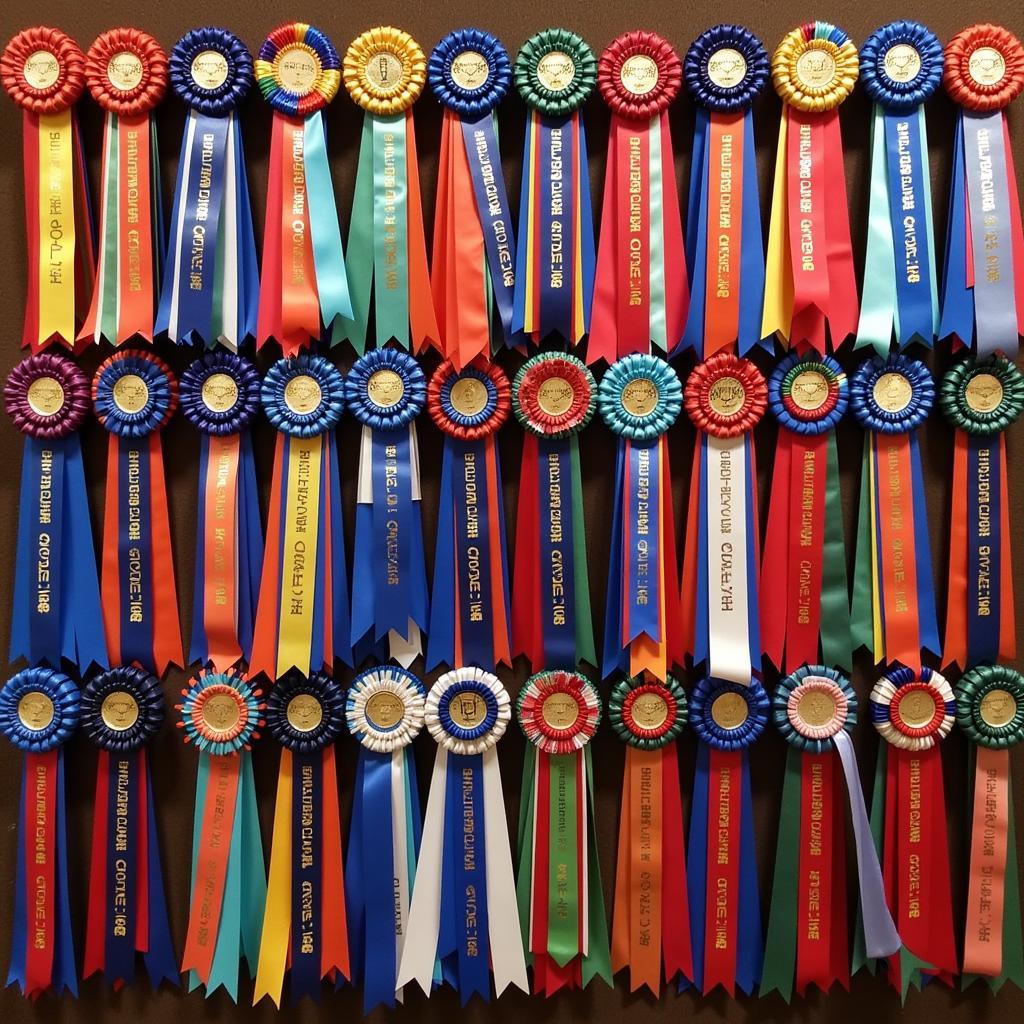The term “Ribbon Horse” might spark curiosity for both seasoned equestrians and newcomers to the horse world. It’s not a specific breed, but rather a symbol of achievement, tradition, and the unique bond between horse and rider. Whether it’s the thrill of a horse show ribbon or the elegance of horse tail ribbons, this guide delves into the significance of ribbon horses and what they represent.
Unveiling the Meaning Behind “Ribbon Horse”
In essence, any horse, regardless of breed, discipline, or skill level, can become a “ribbon horse.” It’s the act of winning awards, usually in the form of ribbons, that bestows this honorary title. These ribbons signify accomplishments in various equestrian events and disciplines, showcasing the horse and rider’s dedication, training, and skill.
 Equestrian Show Ribbon Winners
Equestrian Show Ribbon Winners
The Significance of Horse Ribbons
Horse ribbons aren’t just colorful pieces of fabric; they represent hours of practice, dedication, and the special partnership between horse and rider. Each ribbon tells a story – of perseverance, triumphs, and the unwavering bond between human and animal.
Colors and Categories
Just like the diverse world of equestrian sports, horse ribbons come in a spectrum of colors, each signifying a specific achievement:
- Blue: Often represents first place, signifying exceptional performance.
- Red: Typically denotes second place, acknowledging strong competition and skill.
- Yellow: Usually signifies third place, marking a commendable performance.
- White: Can represent fourth place or participation, emphasizing sportsmanship and effort.
- Other Colors: Some competitions utilize a broader range of colors to denote specific placings or achievements within a class.
 Wall Display of Horse Show Ribbons
Wall Display of Horse Show Ribbons
Beyond placings, special ribbons might be awarded for:
- Sportsmanship: Recognizing exemplary conduct and respect.
- Best in Show: A prestigious award given to the top performer across multiple classes.
- High Point Champion: Awarded to the individual or team accumulating the most points within a specific division or category.
Horse Ribbons Across Disciplines
The concept of the “ribbon horse” transcends disciplines. Whether it’s:
- English Riding: Showcasing elegance and precision in disciplines like dressage, hunter, and jumper classes.
- Western Riding: Emphasizing horsemanship and partnership in events such as reining, barrel racing, and Western pleasure.
- Other Disciplines: From driving to rodeo events, various equestrian disciplines recognize achievements through horse competition ribbons.
A Symbol of Pride and Tradition
The tradition of awarding ribbons in equestrian sports is steeped in history. It’s a way to honor the hard work, dedication, and sportsmanship exhibited by both horse and rider. Displaying these ribbons, whether at home or the stable, becomes a source of pride, marking milestones in an equestrian’s journey.
“A ribbon is more than just a prize; it’s a tangible reminder of the partnership, the hard work, and the sheer joy of riding,” shares Sarah Williams, a seasoned horse trainer with over 20 years of experience.
 Young Rider Grooming Her Horse with Ribbons in the Background
Young Rider Grooming Her Horse with Ribbons in the Background
Beyond the Arena: The Deeper Meaning
While the pursuit of horse show ribbon colors can be exciting, the true essence of a “ribbon horse” lies in the journey. It represents the dedication to training, the unwavering bond between horse and rider, and the continuous pursuit of improvement. It symbolizes the love, respect, and understanding that blossom through horsemanship.
Conclusion
More than just a recipient of awards, a “ribbon horse” embodies the spirit of dedication, partnership, and the pursuit of excellence that defines the equestrian world. Whether adorned with a rainbow of ribbons or just starting their journey, every horse and rider has the potential to become a “ribbon horse” in their own right. It’s the shared journey, the unwavering bond, and the pursuit of shared goals that truly matter.
FAQs
What is the most prestigious horse ribbon?
While specific awards vary by discipline, the “Best in Show” is often considered the most prestigious, recognizing overall excellence across multiple categories.
What do different horse ribbon colors mean?
Typically, blue represents first place, red signifies second, yellow denotes third, and white often represents fourth or participation. However, color designations can vary depending on the competition.
Can any horse become a “ribbon horse”?
Absolutely! Any horse, regardless of breed, age, or discipline, can earn ribbons and become a “ribbon horse” with dedication, training, and a strong partnership with their rider.
Where can I find information about horse tail ribbon colors?
For a deeper understanding of the meanings and traditions associated with different horse tail ribbon colors, be sure to explore our dedicated article on this fascinating topic.
Need more help with your equestrian journey?
Contact us at Phone Number: 0772127271, Email: [email protected] Or visit us at: QGM2+WX2, Vị Trung, Vị Thuỷ, Hậu Giang, Việt Nam. Our dedicated customer support team is available 24/7 to assist you.